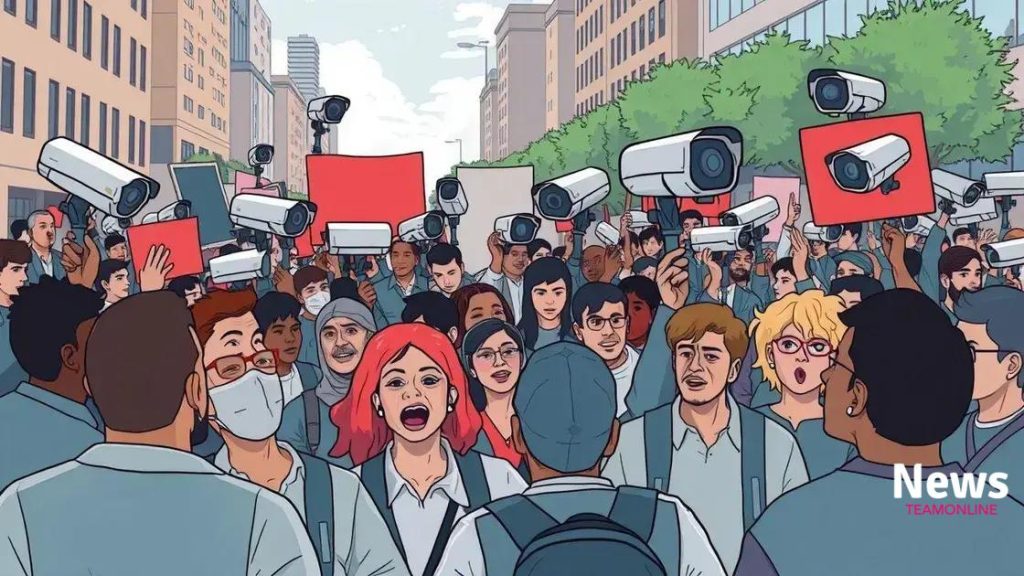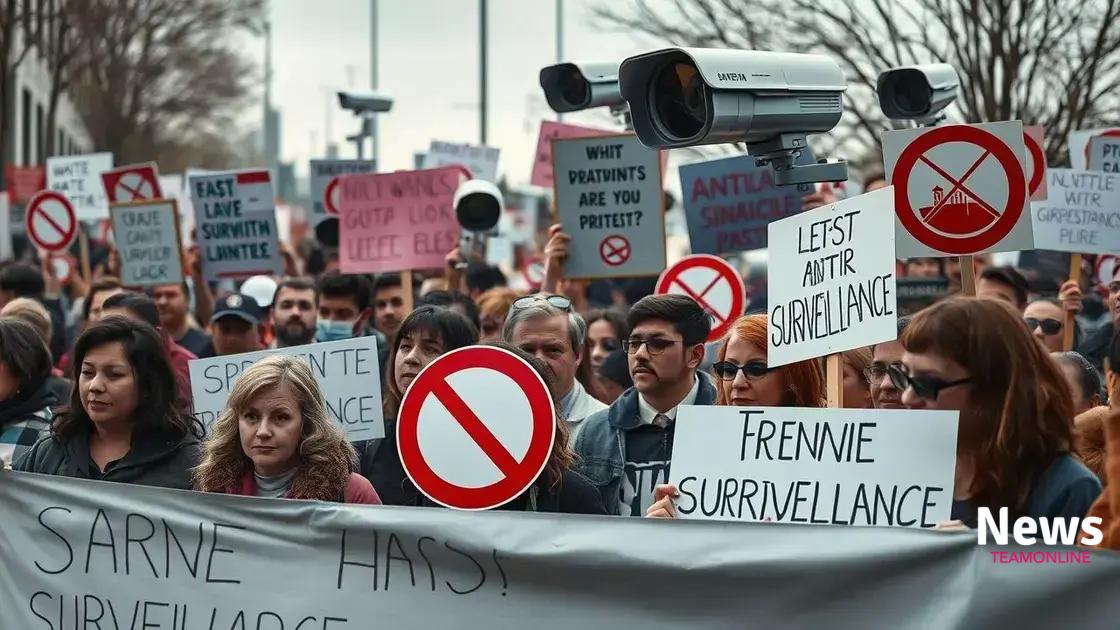Anti-surveillance protest movement: what you need to know

The anti-surveillance protest movement opposes invasive monitoring practices and advocates for privacy rights through grassroots organizing, public awareness campaigns, and legislative changes to protect individuals from government and corporate surveillance.
The anti-surveillance protest movement has gained momentum in recent years as people express their concerns about privacy invasion. Have you noticed how often we are monitored? This article delves into the movement’s roots and significance.
Understanding the origins of anti-surveillance protests
The anti-surveillance protests have roots that can be traced back to a growing concern about privacy and individual rights. Many individuals feel that surveillance technologies are increasingly infringing upon their personal freedoms. To understand the origins, we must look at key events and societal changes.
Historical Context
Throughout history, governments have used surveillance for security and control. The rise of digital technology has made this more pervasive. Public fear of overreach has fueled a backlash against these practices, sparking protests.
Early Activism
One can find early examples of activism against surveillance in the 1960s and 70s, when civil rights movements fought against government monitoring. These movements brought light to the implications of surveillance on freedom of speech and privacy.
- The introduction of video surveillance in public areas.
- Government monitoring of protests and political movements.
- Growing awareness of data privacy issues.
The internet boom in the 1990s further catalyzed concerns. As more people came online, the implications of data collection became increasingly evident. The rise of social media and data analytics prompted fears over personal information being exploited.
Recent Developments
In recent years, events like the Edward Snowden revelations have acted as a catalyst for the anti-surveillance movement. Snowden’s disclosures about the extent of government spying ignited discussions and protests around the globe.
With technology evolving, groups have mobilized to fight back against perceived injustices. Protesters emphasize the need for strict regulations on surveillance practices.
- Formation of organizations advocating for digital privacy.
- Public campaigns against invasive technologies.
- Collaborative efforts with legal experts to draft new privacy laws.
The future of anti-surveillance protests seems promising as more people become aware of their rights. Continued advocacy is crucial to shape a society where individuals can enjoy privacy and security.
Key figures in the anti-surveillance movement
In the anti-surveillance movement, several key figures have played significant roles in raising awareness and advocating for privacy rights. These individuals often bring attention to the dangers of invasive monitoring and encourage collective action.
Edward Snowden
Edward Snowden is perhaps the most famous whistleblower concerning government surveillance. His revelations in 2013 exposed the extent of the National Security Agency’s (NSA) surveillance programs. By sharing this information, Snowden became a symbol for privacy advocates worldwide. His actions sparked debates and protests against mass surveillance.
Julian Assange
Julian Assange, the founder of WikiLeaks, has also been a pivotal figure in the anti-surveillance movement. His organization published classified documents that unveiled government secrets related to surveillance and military actions. Assange’s commitment to transparency has inspired many activists.
- Assange’s work brings to light government accountability issues.
- His legal battles have prompted discussions about freedom of the press.
- Supporters view him as a martyr for the cause of information freedom.
Alongside these figures, there are many grassroots activists who have made vital contributions. These activists often organize local protests and campaigns, creating platforms for community engagement. They help raise awareness of surveillance issues in their communities through social media and public outreach.
Organizations Leading the Charge
Organizations like the Electronic Frontier Foundation (EFF) and the ACLU have been instrumental in championing anti-surveillance causes. They work tirelessly to educate the public on privacy rights and the implications of surveillance technologies. Their legal battles against unjust surveillance practices help protect citizens’ rights.
Many activists are not well known but contribute significantly to the movement. Their passion and dedication drive the fight against surveillance. Through combined efforts, these key figures show that standing up for privacy can bring about change.
Major events that shaped the movement

Major events have significantly shaped the anti-surveillance movement. Each of these moments has galvanized public opinion and heightened awareness of privacy issues. Understanding these events helps illustrate the evolution of the movement.
The Rise of CCTV
The introduction of closed-circuit television (CCTV) in public areas marked a turning point. Initially seen as a tool for enhancing security, many soon realized it represented a growing invasion of privacy. Public backlash began as citizens expressed concerns about being constantly watched.
The Patriot Act
In the United States, the Patriot Act, enacted after the September 11 attacks, expanded government surveillance abilities. This legislation raised alarms among civil liberties groups. Many argue it has allowed for unwarranted monitoring in the name of national security.
- Increased data collection by government agencies.
- Expanded power for law enforcement to conduct surveillance.
- Protests erupted against perceived infringements on civil rights.
The revelations made by whistleblower Edward Snowden in 2013 acted as a catalyst for the movement. When Snowden exposed the extent of the NSA’s surveillance practices, it shocked the world. His leaks revealed that governments were collecting vast amounts of data on ordinary citizens, igniting global protests.
Public Awareness Campaigns
Following Snowden’s disclosures, various organizations launched public awareness campaigns. These efforts aimed to educate people about their rights and the dangers of surveillance. Activists organized mass protests, bringing together like-minded individuals to demand change.
- Protests in major cities worldwide.
- Grassroots campaigns promoting digital privacy.
- Increased media attention on surveillance-related issues.
The emergence of powerful social media platforms has also transformed the landscape of activism. Today, movements can mobilize support quickly and efficiently, amplifying their message. Digital platforms provide essential tools for organizing and raising awareness.
In summary, these major events collectively highlight the concerns surrounding surveillance. They illustrate how public sentiment has evolved over time, strengthening the resolve of privacy advocates.
Strategies used by protesters to raise awareness
Protesters in the anti-surveillance movement have developed numerous strategies to raise awareness about the dangers of invasive monitoring. Understanding these methods helps illustrate how activism can effectively engage the public.
Grassroots Organizing
Grassroots organizing is vital for building a strong community around the cause. Activists often start by educating their local communities about the risks associated with surveillance. Community meetings, workshops, and events help spread the word.
Social Media Campaigns
Social media has transformed activism, providing a platform for rapid outreach. Protesters utilize these platforms to coordinate events and foster discussions. Hashtags like #StopSurveillance and #PrivacyMatters are popular tools to unite voices.
- Sharing personal stories of surveillance experiences.
- Creating visually engaging content addressing privacy issues.
- Encouraging followers to spread the message within their networks.
Online petitions are another effective strategy. These petitions often aim to influence lawmakers by showing significant public support. By gathering thousands of signatures, activists can deliver a clear message about the need for policy changes.
Artistic Expression
Art can also serve as a powerful medium for raising awareness. Many protesters use street art, performances, and installations to create thought-provoking visuals. This artistic approach can capture attention and convey complex ideas simply.
- Murals that depict the negative impacts of surveillance.
- Street performances emphasizing privacy rights.
- Interactive installations that invite public participation.
Additionally, hosting public talks and panels featuring experts can educate the community. Bringing in speakers from various fields can spark interest and discussions around surveillance issues.
Through these diverse strategies, activists aim to foster a deeper understanding of privacy rights. By engaging with the public creatively and dynamically, they work to inspire change in attitudes and policies regarding surveillance.
The future of anti-surveillance activism
The future of anti-surveillance activism looks promising as public interest in privacy rights grows. As technology evolves, activists are adapting their strategies to keep pace with new challenges. This movement is likely to expand its reach and influence in the coming years.
Technological Innovations
As surveillance technologies become more sophisticated, activists are also using new tools to combat them. Innovations like encryption and anonymization software empower individuals to protect their privacy online. These tools are essential for reducing the footprint of surveillance in daily life.
Increased Collaboration
Future activism will likely see increased collaboration among various organizations. By joining forces, groups can maximize their impact and reach a broader audience. This collaboration can include sharing resources, expertise, and grassroots efforts to promote privacy rights.
- Partnerships between tech companies and advocacy groups.
- Joint awareness campaigns across different platforms.
- Collaborative research to influence policy changes.
Education is another critical element that will shape the future of activism. As more people become aware of privacy issues, they can take action. Schools and communities may begin incorporating digital rights education into their curricula, preparing future generations to advocate for privacy rights.
Legislative Changes
Future anti-surveillance activism will also focus on pushing for legislative changes. Advocates will continue to work with lawmakers to ensure that privacy rights are protected. This may result in new regulations that limit surveillance practices.
- Stricter laws on data collection by companies.
- Stronger protections for whistleblowers exposing surveillance abuses.
- Policies promoting transparency in government surveillance practices.
The role of social media will remain crucial as platforms continue to evolve. Activists will use these channels to inform and mobilize supporters quickly. With the ongoing advancements in digital communication, the potential for rapid mobilization increases.
As society becomes more aware of the implications of surveillance, activism will likely shift toward a proactive approach. This means not only addressing issues as they arise but also anticipating future challenges and advocating for preventative measures.
FAQ – Questions Frequently Asked About the Anti-Surveillance Movement
What is the anti-surveillance movement?
The anti-surveillance movement advocates for privacy rights and opposes invasive monitoring technologies used by governments and corporations.
How can I get involved in the anti-surveillance movement?
You can get involved by participating in local advocacy groups, attending protests, and spreading awareness on social media about privacy issues.
What strategies do activists use to raise awareness?
Activists use various strategies, including grassroots organizing, social media campaigns, educational initiatives, and artistic expression to engage and inform the public.
What does the future look like for anti-surveillance activism?
The future looks promising, with growing public awareness, collaboration among organizations, and continued advocacy for legislative changes to protect privacy rights.





